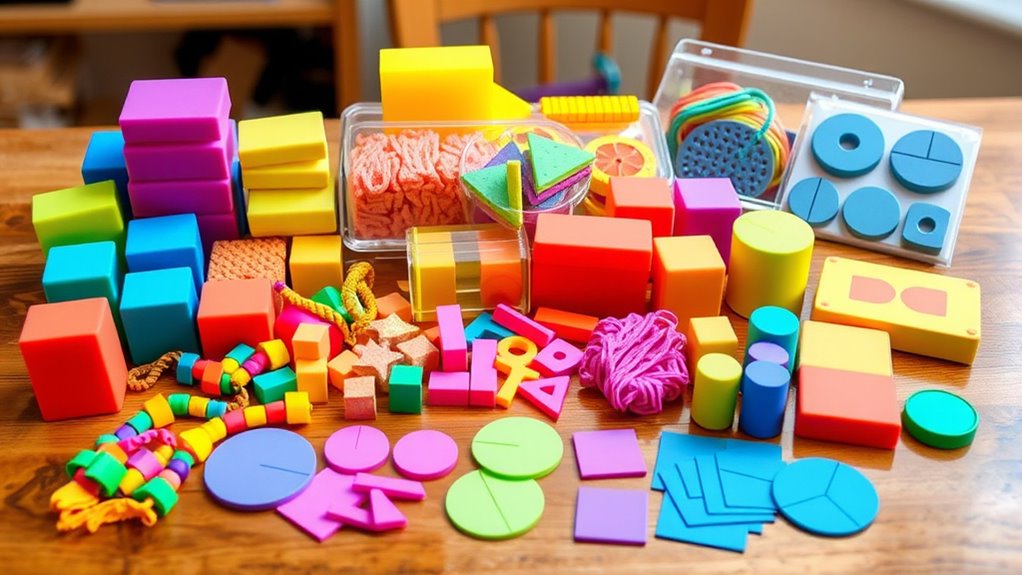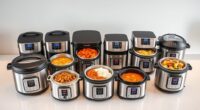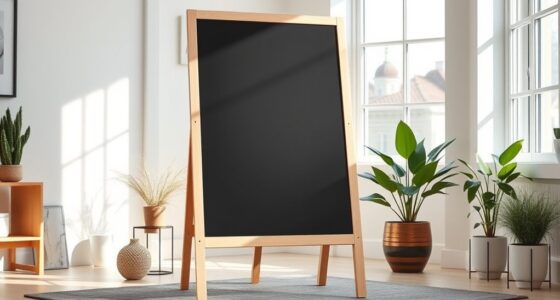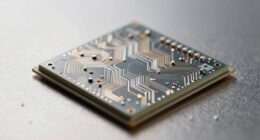If you’re searching for the best math manipulative kits for homeschoolers, I can help. I’ve explored options like colorful base ten blocks, fraction circles, and interactive puzzles that make math fun and engaging. These kits support hands-on learning, boost confidence, and simplify lesson planning. Many include durable materials, activity cards, and storage solutions perfect for young learners. Keep going to discover detailed reviews and how these kits can transform your child’s math experience.
Key Takeaways
- Highlight kits with colorful, durable components that support hands-on, multisensory learning for kids aged 3-10.
- Emphasize comprehensive sets including base ten blocks, fraction circles, and activity cards for varied math concepts.
- Focus on kits that promote engagement, confidence, and active exploration through visual and tactile methods.
- Consider features like portability, organization, and safety to enhance usability in homeschooling environments.
- Identify sets that align with educational standards and support diverse learning styles for maximum effectiveness.
hand2mind Take Home Math Manipulatives Kit for Kids Grade K-2
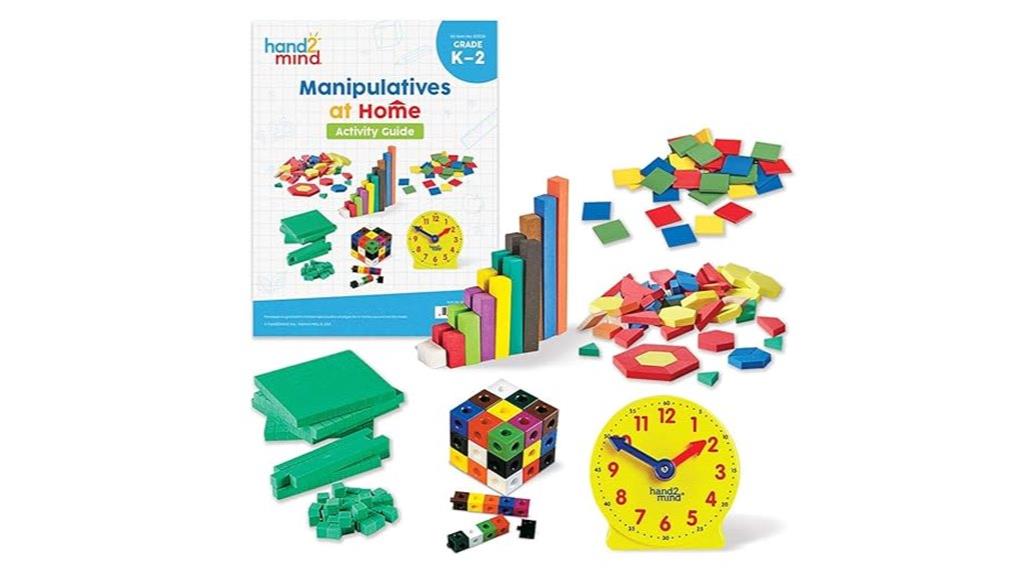
If you’re homeschooling a child in grades K-2, the hand2mind Take Home Math Manipulatives Kit is a fantastic choice to make learning engaging and hands-on. This all-in-one set includes 74 foam Cuisenaire rods, base ten units, pattern blocks, snap cubes, and a geared clock, covering essential math concepts like addition, subtraction, fractions, and time. The colorful, durable materials are perfect for young learners, helping them visualize and explore abstract ideas easily. With an easy-to-follow guide packed with activities, it promotes active discovery, boosts understanding, and makes math fun, whether at home or in a classroom.
Best For: homeschooling parents, teachers, and caregivers of children in grades K-2 seeking a comprehensive, hands-on math learning tool.
Pros:
- Includes a wide variety of durable, colorful manipulatives that support multiple math concepts.
- Comes with an easy-to-follow activity guide that promotes active, discovery-based learning.
- Enhances understanding of abstract ideas like fractions, time, and operations through tactile engagement.
Cons:
- Packaging may be excessive or less environmentally friendly.
- Some users may find the quantity of plastic packaging cumbersome to store or dispose of.
- The set may be too extensive for very young or beginner learners who need smaller, simpler kits.
Learning Resources Time Activity Set (41 Pieces)
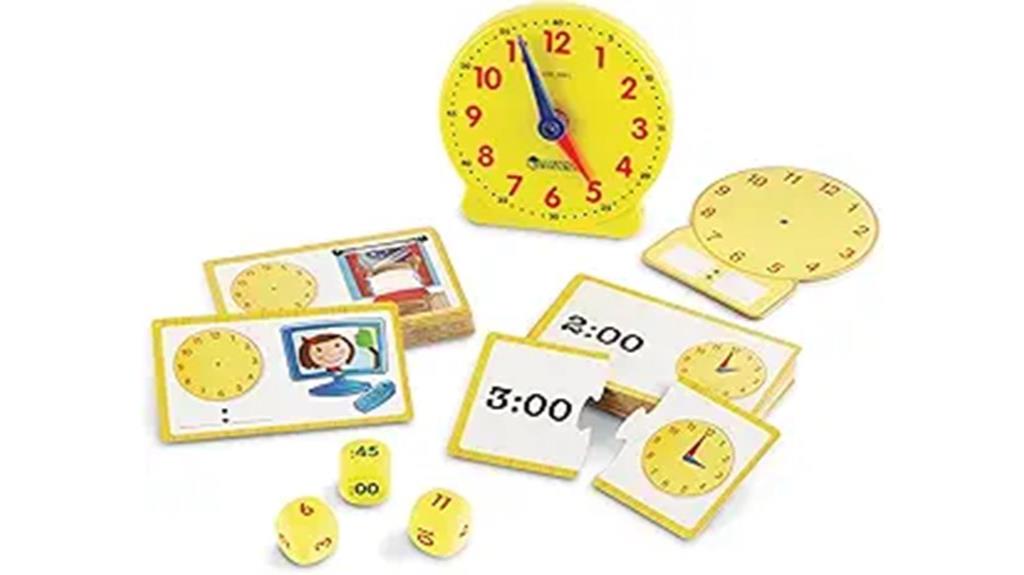
The Learning Resources Time Activity Set (41 Pieces) stands out as an ideal choice for elementary homeschoolers who want an extensive, hands-on way to master telling time. This set includes a durable plastic clock with movable hands, a write & wipe clock, and 24 double-sided puzzle cards that cover analog and digital time. With 12 daily activity cards, 3 time dice, and an activity guide, it offers versatile learning options. The color-coded hands clearly differentiate hours and minutes, making concepts easier to grasp. Kids develop skills in time-telling, matching, writing, and problem-solving while having fun, whether independently or in groups.
Best For: elementary homeschoolers and teachers seeking a comprehensive, hands-on tool to teach telling time and related skills effectively.
Pros:
- Durable, high-quality plastic clock with movable gear-driven hands for easy manipulation
- Includes a variety of interactive materials like puzzle cards, activity dice, and daily routine cards to enhance engagement
- Supports multiple learning styles with visual, tactile, and kinesthetic activities, making concepts accessible and fun
Cons:
- May be more suitable for ages 5+ and less appropriate for younger children due to complexity
- Larger sets might require dedicated storage space and organization
- Some users may find the extensive components overwhelming initially, requiring guidance to maximize learning benefits
edxeducation Transparent Counters Set of 500 for Kids

The edxeducation Transparent Counters Set of 500 is an excellent choice for homeschooling parents seeking a versatile and durable math resource for young learners. With six bright colors and 0.75-inch diameter counters, it’s perfect for developing skills like counting, sorting, and basic operations. The set’s transparency allows for overlay activities and visual classification, making math concepts engaging and clear. Packaged in a resealable bag, it’s easy to store and keep organized. Made of sturdy, safe plastic with no sharp edges, these counters are built to last through years of use in homeschooling, classroom, or group settings. They truly make learning math fun and hands-on.
Best For: homeschooling parents, early childhood educators, and caregivers seeking a durable, versatile math manipulative set for young learners.
Pros:
- Bright, vivid colors enhance engagement and visual learning.
- Transparent design allows for overlay activities and easy color matching.
- Made of sturdy, safe plastic with no sharp edges, suitable for children aged 3 and up.
Cons:
- The counters are smaller than some users expect, which may limit use for very young children with fine motor challenges.
- The set is primarily designed for individual or small group use, limiting large group activities.
- Although durable, frequent washing may cause slight fading of the shiny colors over time.
Take Home Math Manipulatives Kit for Kids Grade K-3

Designed specifically for children in grades K-3, the Take Home Math Manipulatives Kit offers a hands-on approach to learning essential math skills. It includes a variety of tools like ten-frames, counters, tens rods, and pattern blocks, providing a complete set for engaging, tactile learning. This kit helps kids grasp concepts like addition, subtraction, place value, and geometry through fun activities. Perfect for homeschoolers, it promotes school readiness and builds confidence by making math interactive and accessible. Whether used individually or in small groups, this all-in-one resource makes mastering foundational math skills both effective and enjoyable.
Best For: parents, teachers, and educators seeking a comprehensive, hands-on math learning tool for children in grades K-3 to enhance foundational skills through engaging manipulatives.
Pros:
- Provides a diverse set of manipulatives that support multiple math concepts including addition, subtraction, and geometry
- Encourages tactile, interactive learning suitable for individual or small group instruction
- Supports school readiness and confidence-building in young learners
Cons:
- May require additional guidance or instructions for effective activity implementation
- Limited to grades K-3, not suitable for older students
- The set’s size and variety might be overwhelming for some users without proper organization
Carson Dellosa Be Clever Wherever K-1 Math Tool Kit

Looking for a math manipulative kit that’s perfect for young learners just starting their math journey? The Carson Dellosa Be Clever Wherever K-1 Math Tool Kit is a fantastic choice. It’s portable, colorful, and designed to make math fun and accessible outside the classroom. With 30 durable pieces—including counters, dice, charts, and a fun facts wheel—it covers key skills like number recognition, counting, shapes, and basic operations. The compact storage case keeps everything organized, making it easy to use at home or on the go. This kit encourages hands-on learning and helps reinforce foundational math concepts in an engaging way for kindergarten and first-grade students.
Best For: young learners in kindergarten and first grade seeking a portable, engaging math manipulative kit to reinforce foundational skills outside the classroom.
Pros:
- Includes a variety of durable, colorful manipulatives like counters, dice, and charts that promote hands-on learning.
- Compact storage case makes it easy to organize and carry, ideal for use at home or on the go.
- Supports essential early math skills such as number recognition, counting, shapes, and basic operations with engaging tools.
Cons:
- Some users mention that the quality of plastic components could be improved for greater durability.
- Limited number of pieces may restrict more complex or extended activities.
- It may require additional resources or guidance for optimal use in a structured learning environment.
SYNARRY Wooden Ten-Frame Set Math Manipulatives for Kids

If you’re homeschooling a young learner who’s just starting to grasp basic math concepts, the SYNARRY Wooden Ten-Frame Set offers an engaging, hands-on approach to building foundational skills. With six sturdy wooden ten-frames, colorful counters, dice, number stones, and reusable activity cards, it provides versatile tools for teaching addition, subtraction, multiplication, and skip counting. The set’s bright colors and interactive components make learning fun and memorable, while the included dry-erase boards encourage practice. Compact and durable, it’s perfect for homeschooling, preschool, or remote learning environments, helping kids visualize math concepts and develop confidence through engaging activities.
Best For: homeschooling parents, early elementary teachers, and caregivers seeking an engaging, safe, and versatile math manipulative set to support foundational math skills for children aged 36 months to 10 years.
Pros:
- Includes a comprehensive set of durable, FSC-certified wooden components with bright, engaging colors that promote visual learning.
- Facilitates a variety of math activities such as addition, subtraction, multiplication, and skip counting, fostering interactive and hands-on learning.
- Compact, lightweight design with storage options makes it easy to use at home or on the go, suitable for multiple learning environments.
Cons:
- The small size of counters may pose a choking hazard for very young children under 3 years old.
- Some users report that the whiteboard eraser tip requires light water cleaning for optimal use.
- Limited to basic math concepts; advanced math activities may require additional tools or resources.
hand2mind Math Manipulatives Kit for Kids Grade 3-5
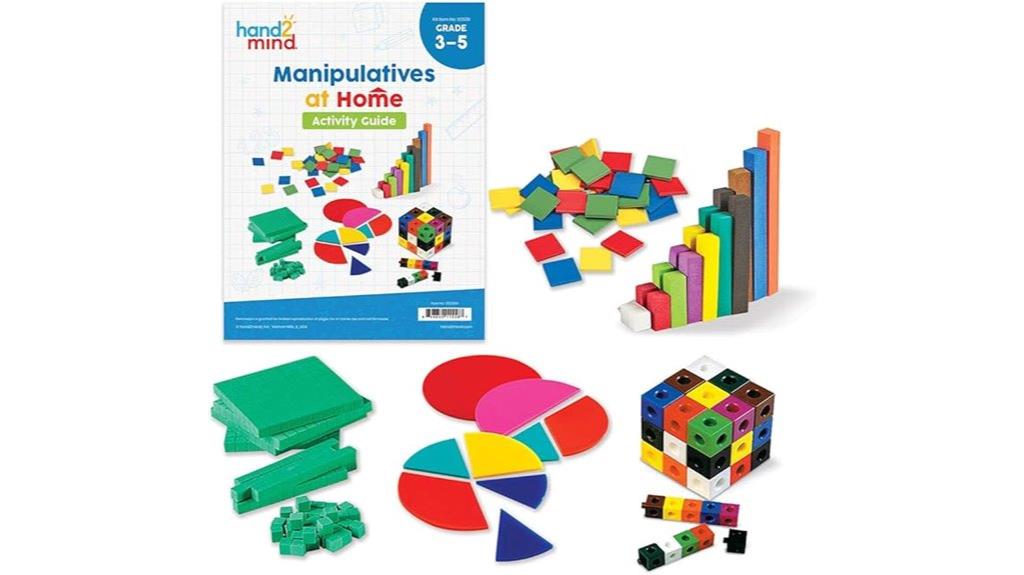
The hand2mind Math Manipulatives Kit for Kids in grades 3-5 is an excellent choice for homeschooling families seeking an all-inclusive set of tools to support a wide range of math concepts. This exhaustive kit combines foam base ten blocks, counting chips, fraction circles, linking cubes, and cuisenaire rods, all in one package. It simplifies lesson planning and helps children grasp place value, fractions, patterns, and number relationships through hands-on learning. Perfect for both remote and in-person instruction, this versatile kit makes math engaging and accessible, fostering confidence and understanding in young learners. It’s a practical, value-packed resource for homeschooling success.
Best For: homeschooling families and educators seeking a comprehensive, all-in-one math manipulatives kit suitable for students in grades 3-5 to enhance hands-on learning and understanding of core math concepts.
Pros:
- Includes a wide variety of manipulatives such as base ten blocks, fraction circles, linking cubes, cuisenaire rods, and counting chips, providing versatile teaching tools.
- Simplifies lesson planning and resource management by offering an all-inclusive set in one package.
- Supports both remote and in-person learning, making math lessons engaging and accessible for young learners.
Cons:
- The large variety of items may be overwhelming for some users to organize or store effectively.
- The kit may be more expensive than purchasing individual manipulatives separately, which could be a concern for budget-conscious families or schools.
- Limited information on the durability of foam and plastic components for long-term use or frequent handling.
Torlam 131 PCS Base Ten Blocks for Math

Teachers and homeschooling parents will find the Torlam 131 PCS Base Ten Blocks an excellent tool for helping students grasp fundamental math concepts. Designed for hands-on learning, this set helps kids understand place value, operations, decimals, and measurements through visual and tactile methods. The colorful plastic pieces include units, rods, flats, and a cube, making abstract ideas tangible. The sturdy, lightweight design guarantees durability and easy handling. With a write-and-wipe mat and organizer, kids can build, solve, and explore math concepts actively. Suitable for 1st to 3rd graders, these manipulatives make learning engaging, effective, and fun.
Best For: educators, homeschooling parents, and students in grades 1 to 3 seeking hands-on tools to enhance understanding of math concepts like place value, operations, and measurements.
Pros:
- Durable and lightweight plastic ensures long-lasting use and easy handling.
- Vibrant colors and comprehensive set (units, rods, flats, cubes) facilitate visual and tactile learning.
- Includes a write-and-wipe mat and organizer for active engagement and easy storage.
Cons:
- Designed primarily for early elementary, limited for advanced math concepts.
- Some users may find the size of the pieces too small for very young children.
- The set may require additional materials or guidance for complex problem-solving activities.
edxeducation Math Cubes Set of 100 Counting Blocks with 5 Shapes
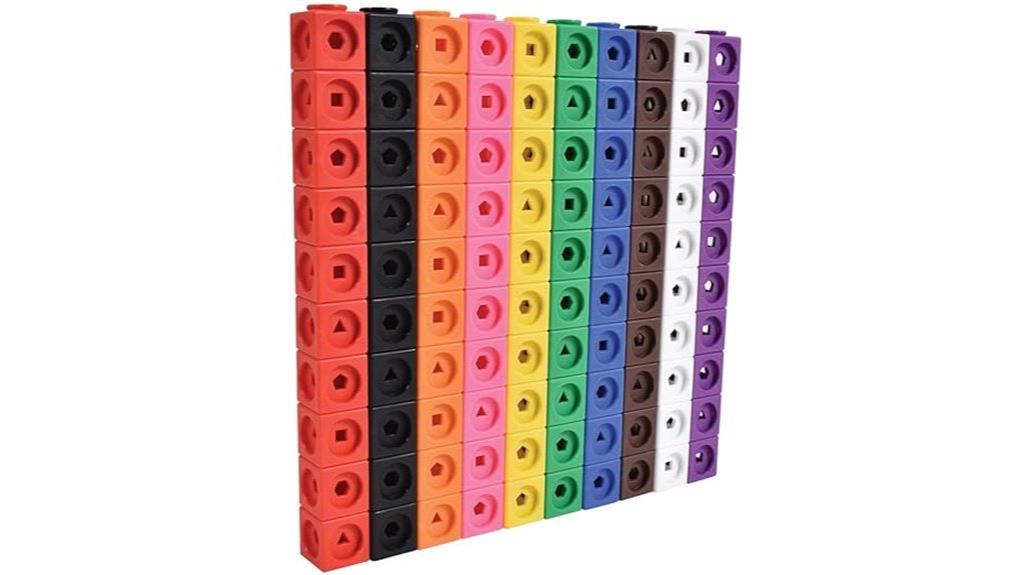
For homeschoolers looking to make math learning engaging and tactile, the edxeducation Math Cubes Set of 100 Counting Blocks with 5 Shapes stands out as an excellent choice. These colorful plastic cubes feature five geometric shapes—circle, square, triangle, pentagon, and hexagon—on five sides, making pattern recognition and shape identification fun. They snap securely with a satisfying click, encouraging hands-on exploration. Suitable for children aged 3 and up, these durable cubes promote fine motor skills, counting, sorting, and basic math concepts. The included activity guide offers creative ways to integrate them into lessons, making math both educational and enjoyable.
Best For: homeschooling parents, teachers, and caregivers seeking a hands-on, engaging tool to teach early math concepts and shape recognition to children aged 3 and up.
Pros:
- Colorful, durable plastic cubes with five geometric shapes on five sides promote visual and tactile learning.
- Secure linking mechanism with satisfying click encourages exploration and fine motor development.
- Versatile for a wide range of activities including counting, sorting, pattern building, and early geometry.
Cons:
- Some users note the cubes are less sturdy than LEGO bricks, potentially affecting long-term durability.
- The price point may be higher compared to simpler counting manipulatives.
- Missing pieces or minor defects could occur, requiring careful quality checks or replacement requests.
Magnetic Fraction Tiles & Circles Set with Dry Erase Board for Grades 1-5
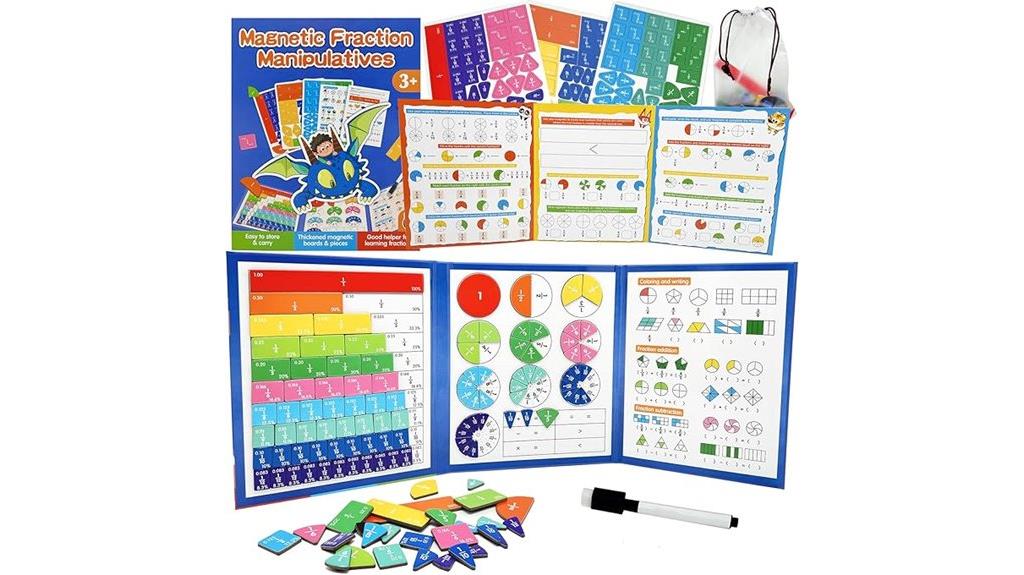
If you’re looking for a versatile tool to help children understand fractions, the Magnetic Fraction Tiles & Circles Set with Dry Erase Board is an excellent choice for grades 1-5. It offers bright, tactile fraction pieces from 1/2 to 1/12, allowing kids to visualize and compare parts and wholes. The set promotes independent, hands-on learning inspired by Montessori principles, encouraging kids to explore size and value through manipulation. With reusable dry-erase practice cards and a marker, children can practice problems repeatedly. Its portability and organized storage make it ideal for home, classroom, or tutoring, providing engaging, real-world fraction understanding.
Best For: educators, parents, and homeschoolers seeking a tactile and visual tool to teach fractions to children in grades 1-5.
Pros:
- Engages children with bright, tactile fraction pieces for hands-on learning
- Promotes independent exploration and understanding of fractions based on Montessori principles
- Includes reusable dry-erase practice cards for ongoing skill reinforcement
Cons:
- May require additional instruction for children unfamiliar with tactile learning methods
- Limited to fraction sizes from 1/2 to 1/12, which may not cover all advanced fraction concepts
- The set’s size and components might be less suitable for very large group settings without additional materials
Magnetic Fraction Tiles & Circles for Classroom Learning
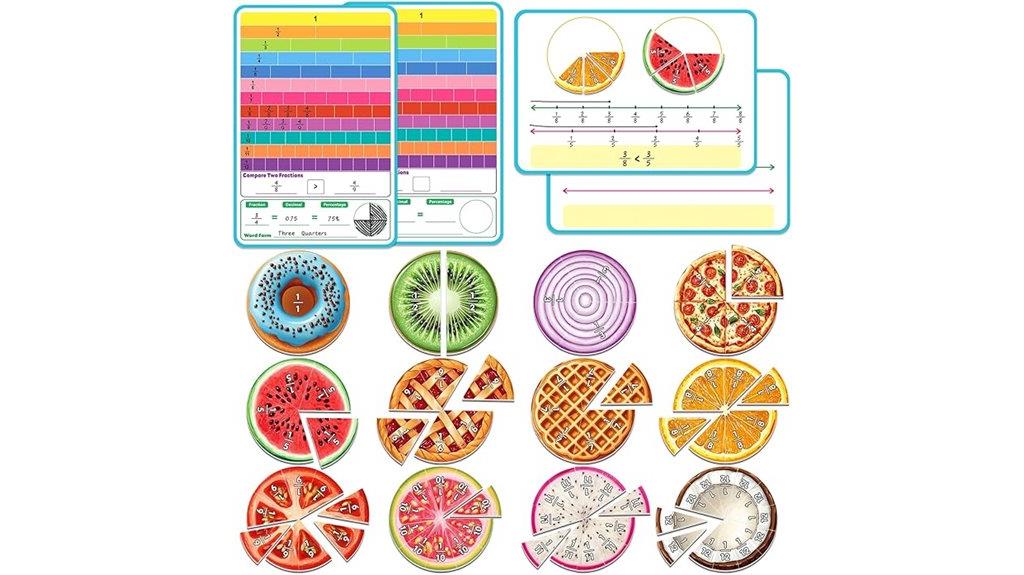
Magnetic fraction tiles and circles are an excellent choice for educators and homeschoolers seeking a hands-on way to teach fractions effectively. This set includes 12 colorful magnetic fraction circles (whole to 1/12) and 6 activity cards, all made from durable EVA foam with laminated surfaces. The bright colors help students visually compare and understand fractions, making concepts like ordering and operations easier. The strong magnets stick securely to whiteboards and metal surfaces, enabling interactive lessons. Perfect for grades 2-5, these manipulatives make learning engaging, supporting diverse teaching methods while providing a sturdy, safe, and visually appealing tool for classroom or homeschool use.
Best For: educators, homeschooling parents, and tutors working with students in grades 2-5 to make learning fractions engaging and hands-on.
Pros:
- Bright, multi-colored pieces that visually differentiate fractions, enhancing understanding
- Durable EVA foam construction with scratch-resistant laminated surfaces for longevity
- Strong magnets that adhere securely to whiteboards and metal surfaces, facilitating interactive lessons
Cons:
- Smaller fraction pieces (for 11th and 12th fractions) may be easy to lose, especially with younger children
- Slight chemical odor upon opening that dissipates over time
- Some users may find the set’s size and number of pieces limiting for larger classes or more advanced lessons
Aizweb Regrouping Base Ten Place Value Math Manipulatives and Dry Erase Board for Grade 1-3 Students
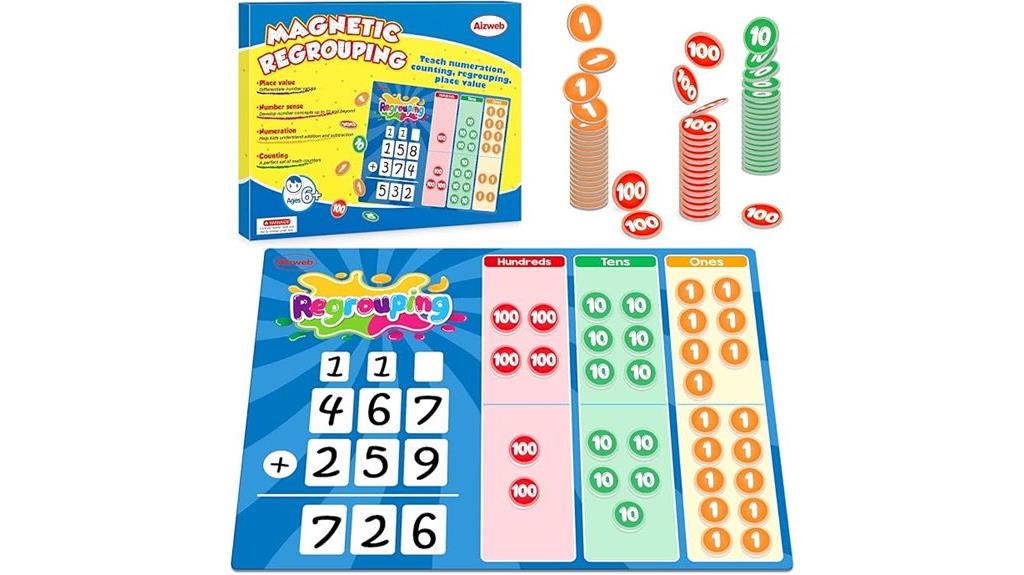
The Aizweb Regrouping Base Ten Place Value Math Manipulatives and Dry Erase Board stands out as an excellent choice for educators and homeschooling parents seeking to help children grasp addition, subtraction, and regrouping concepts. This kit provides a hands-on approach, with colorful chips representing ones, tens, and hundreds, making abstract ideas visual and easier to understand. The durable, magnetic dry erase mat allows for interactive problem-solving, while its easy-to-clean surface supports repeated use. Ideal for students in grades 1-3, it promotes engagement, enhances place value understanding, and builds confidence in math skills through fun, visual learning.
Best For: educators, homeschooling parents, and students in grades 1-3 who want to develop a solid understanding of place value, addition, subtraction, and regrouping through hands-on, visual learning tools.
Pros:
- Engages students with colorful, visual manipulatives that simplify complex math concepts.
- Durable, reusable dry erase surface supports long-term use and easy cleaning.
- Promotes interactive learning, building confidence and problem-solving skills in young learners.
Cons:
- May require additional space or magnetic surface for optimal use.
- Some children might need guidance initially to fully understand how to use the manipulatives effectively.
- Limited to basic operations; advanced math concepts may require supplementary resources.
D-FantiX Wooden Fraction Educational Puzzle Set
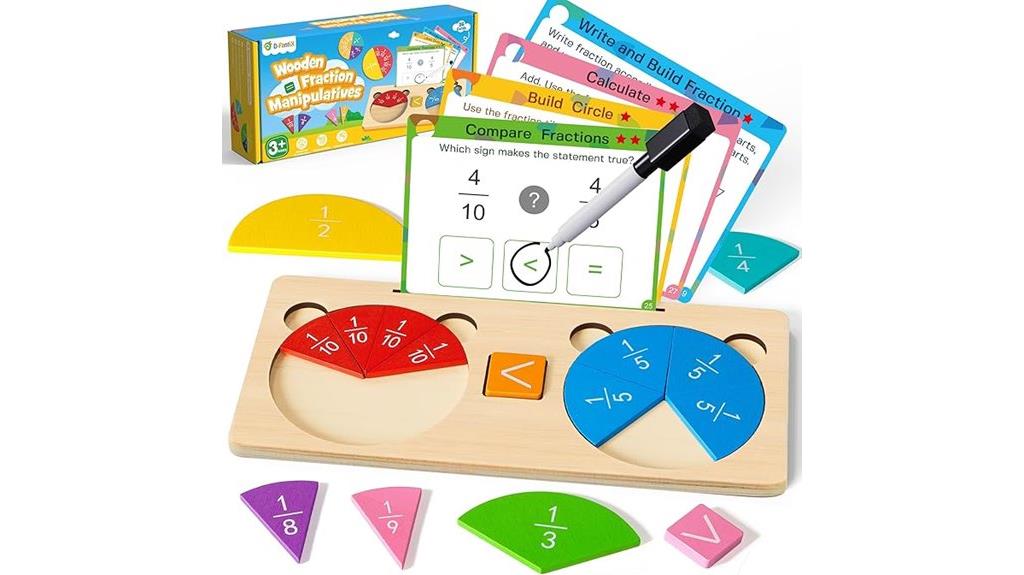
For homeschoolers seeking an engaging, hands-on way to teach fractions, the D-FantiX Wooden Fraction Educational Puzzle Set stands out as an excellent choice. It helps students grasp fractions visually and kinesthetically through colorful wooden tiles, circles, and comparison symbols. The set includes activity cards, a dry erase marker, and a sturdy storage bag, making it versatile for various learning environments. Designed for elementary students and beyond, it promotes understanding of size, equivalence, and calculation. Its durable, natural wood construction and interactive features make learning fractions fun, practical, and easy to reinforce through repeated use, whether at home, in class, or outdoors.
Best For: homeschoolers, teachers, and parents seeking a durable, interactive tool to teach fractions to elementary students and beyond through visual and hands-on learning.
Pros:
- Engages multiple learning styles with colorful, tactile wooden pieces and visual aids
- Promotes understanding of fractions, size comparison, and equivalence through interactive play
- Portable and durable design, suitable for various environments like home, classroom, or outdoor activities
Cons:
- Some users report that the magnetic strength of the tiles could be stronger for more secure placement
- May require adult supervision for younger children to ensure proper handling and use of components
- Limited to fractions up to twelfth, which might not cover advanced fractional concepts for older students
Factors to Consider When Choosing Math Manipulative Kits for Homeschoolers
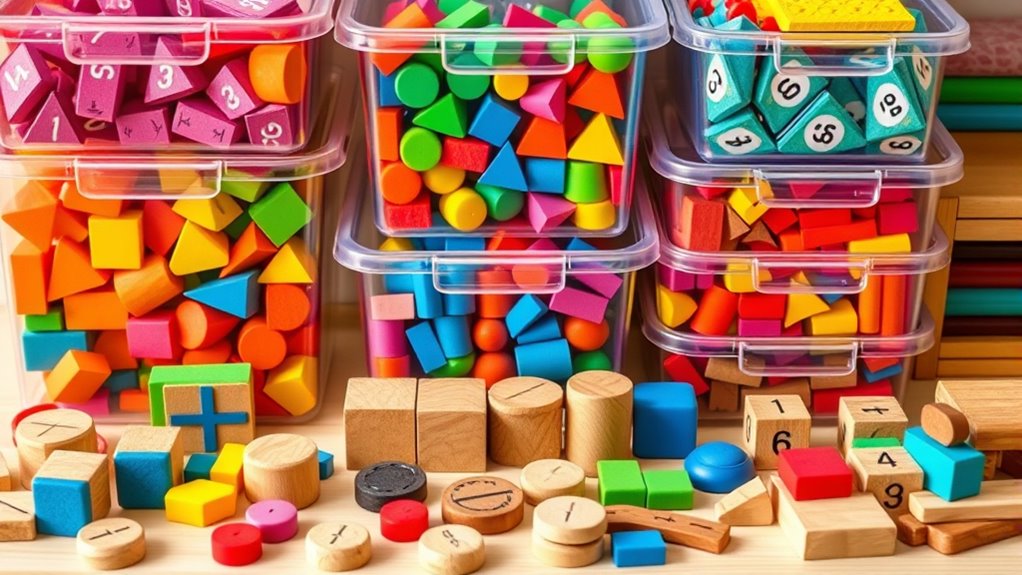
When selecting math manipulative kits, I focus on ensuring the materials are appropriate for the child’s age to keep them engaged and challenged. I also consider how versatile the tools are, along with their quality and durability, so they last through repeated use. Additionally, it’s important to think about how well the kit aligns with educational goals and whether it offers easy storage and organization options.
Age-Appropriate Materials
Choosing math manipulative kits that match a child’s developmental stage is essential for effective learning. For preschoolers aged 3-5, look for kits with large, soft, tactile objects like foam counters and chunky blocks. These materials support fine motor skills and early number recognition while ensuring safety with rounded edges and non-toxic materials. For elementary students in grades K-5, select kits with smaller, more precise tools such as fraction circles, base ten blocks, and linking cubes, which align with their growing cognitive abilities. Properly matched materials prevent children from feeling overwhelmed or under-challenged, fostering confidence and sustained engagement. Ensuring the tools are safe, durable, and age-appropriate helps create a positive, effective learning environment that nurtures a love for math.
Versatility of Tools
A versatile math manipulative kit is like a Swiss Army knife for homeschooling, offering a range of tools that support multiple concepts and activities. With items like base ten blocks, pattern blocks, fraction circles, and number counters, the kit can be used across various math topics. These tools serve different functions—counting, sorting, modeling, and problem-solving—making the kit adaptable for different learning styles and levels. They support both concrete and visual learning, helping students shift smoothly from tactile exploration to abstract reasoning. Additionally, tools that can be used for multiple topics—such as time, geometry, and operations—maximize the kit’s usefulness. Modular components allow for easy customization, ensuring the kit remains flexible and aligned with different curricula and individual needs.
Quality and Durability
Ensuring the quality and durability of math manipulative kits is essential because these tools need to withstand frequent handling and active learning. I look for kits made from high-quality materials like thick plastic, wood, or foam, which resist cracking, fading, and peeling over time. Smooth edges and non-toxic finishes are vital for safety and longevity, especially when children handle them daily. I also check for components that are resistant to wear and tear, ensuring they won’t break easily. A sturdy storage container is a bonus, protecting the manipulatives and keeping everything organized for long-term use. When reviews highlight durability, I feel confident that the kit can endure the demands of homeschooling without needing constant replacement.
Educational Alignment
Have you ever considered how well a math manipulative kit aligns with your homeschooling curriculum? Ensuring this alignment is essential for cohesive lesson planning and meeting learning objectives. I recommend verifying that the kit covers key mathematical areas like number sense, operations, fractions, and geometry, matching your educational goals. It’s also important to choose kits that incorporate visual, tactile, and kinesthetic tools, which help reinforce understanding and support diverse learning styles. Additionally, confirm the manipulatives are appropriate for your child’s grade level and developmental stage—this promotes confidence and effective skill development. Finally, look for resources that provide extensive guidance and activity ideas aligned with educational standards, making it easier to implement a well-rounded, standards-based math program at home.
Storage and Organization
Choosing the right storage options is essential for keeping math manipulatives organized and easily accessible during homeschooling sessions. Effective solutions like resealable bags, sturdy boxes, or stackable containers make it simple to keep pieces sorted and prevent loss. Compact, lightweight designs are ideal for portability, allowing easy transport and storage in small spaces or on the go. Clear labeling and compartmentalized trays help with quick identification and sorting, reducing setup time and encouraging independent use. Durable, spill-proof containers protect small pieces from damage and ensure longevity. Organized kits with designated storage for each type of manipulative support systematic learning, minimize clutter, and promote responsible handling by children. Proper storage transforms chaos into a productive, engaging math learning environment.
Safety Features
Safety features are essential when selecting math manipulative kits for homeschooling, as young children are naturally curious and may put objects in their mouths or mishandle small parts. I look for kits made from non-toxic, BPA-free, and hypoallergenic materials to prevent health risks. It’s vital that all components have smooth edges and are free from sharp points to avoid cuts or injuries. I also check that the size of the pieces is appropriate for the child’s age, especially under three years old, to reduce choking hazards. Additionally, I prefer products that meet safety standards like ASTM or CE certifications, which indicate adherence to recognized safety regulations. Finally, I avoid kits with excessive small parts or loose components that could pose ingestion or inhalation risks during active play.
Budget Considerations
When selecting a math manipulative kit for homeschooling, it’s important to take into account your budget to guarantee you’re getting the best value for your money. First, determine your price range and compare the total costs of different kits to find affordable options without sacrificing quality. Consider whether a thorough, all-in-one kit offers better value than buying individual components separately. Don’t forget to account for additional expenses like storage containers, replacement parts, or extra materials you might need later. Review the price-to-benefit ratio, prioritizing durable, multi-purpose manipulatives that provide long-term educational value. Investing in high-quality, versatile tools may cost more upfront but can save money over time by reducing the need for replacements, making your purchase both cost-effective and educationally sound.
Frequently Asked Questions
How Do Math Manipulative Kits Enhance Critical Thinking Skills?
Math manipulative kits boost critical thinking by encouraging me to explore problems actively and find solutions creatively. They make abstract concepts tangible, so I can visualize and analyze patterns, relationships, and strategies more easily. As I manipulate objects, I develop a deeper understanding, which sharpens my reasoning skills. These hands-on tools challenge me to think critically, experiment, and adapt my approach, making learning both fun and intellectually stimulating.
Are Manipulative Kits Suitable for Different Learning Styles?
Absolutely, manipulative kits are versatile enough for all learning styles. I’ve seen visual learners thrive with colorful blocks, while tactile learners enjoy hands-on activities that make abstract concepts concrete. Auditory learners benefit from discussions around the tools, and even kinesthetic learners stay engaged through movement and manipulation. No matter how your child learns best, these kits can adapt and make math both fun and accessible.
How Often Should Homeschoolers Incorporate Manipulatives Into Lessons?
I recommend incorporating manipulatives into lessons at least 2-3 times a week to keep students engaged and reinforce concepts. I find that regular use helps solidify understanding and makes math more interactive. Sometimes, I introduce them for quick review sessions or hands-on activities. Adjust the frequency based on your child’s needs, but consistent use definitely makes learning more fun and effective.
Can Manipulative Kits Support Advanced Math Concepts?
Yes, manipulative kits can definitely support advanced math concepts. I find them especially useful for visualizing complex ideas like algebra, geometry, and fractions. They help me and my kids grasp abstract concepts by making them tangible, which boosts understanding and confidence. Incorporating advanced tools like algebra tiles or geometric solids keeps lessons engaging and hands-on, ensuring that even challenging topics become approachable and fun to explore.
What Safety Features Should Parents Look for in Manipulative Kits?
Think of manipulative kits as the keys to a child’s learning castle. I always look for kits with smooth edges, non-toxic materials, and secure parts that won’t easily break or pose choking hazards. It’s also smart to choose kits with clear age recommendations and sturdy storage. These features guarantee safety while keeping math fun and engaging. Always remember, safety is the foundation of effective learning!
Conclusion
Choosing the right math manipulative kit is like finding a trusty compass on a journey—guiding your child through the enchanting landscape of numbers and shapes. With the perfect tools in hand, math becomes a lively adventure rather than a daunting mountain. So, immerse yourself with confidence, knowing each kit is a key that opens curiosity and sparks a lifelong love for learning. Let’s turn math into their favorite story to tell.
